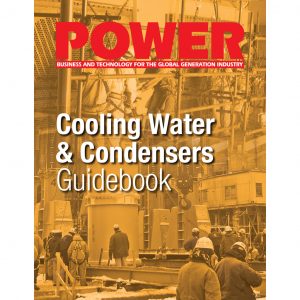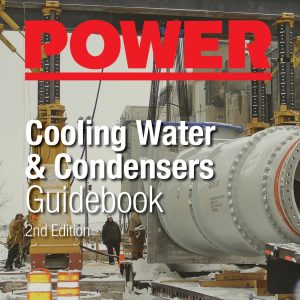Description
This guidebook exclusively features cooling water and condensers articles, including full charts, photographs, graphs and step-by-step instructions, previously featured in POWER magazine. Topics cover plant upgrades, cooling water options, titanium tubing, keeping condensers clean, technology updates and much more.
Available in a PDF format. 78 pages.
Table of Contents
Oak Creek Power Plant Upgrades Cooling Water System
Formed suction intake designs have been used in many large vertical pump stations in flood control projects. Space limitations at the Oak Creek Power Plant Expansion Project near Milwaukee, Wisconsin, created a unique opportunity to apply this technology to an 800,000-gpm cooling water system upgrade for the entire Oak Creek Power Plant.
Enhanced Condenser Tube Designs Improve Plant Performance
Enhanced condenser tube designs can significantly improve the heat rate and performance of fossil and nuclear plants. Using the optimum number of
tubes and replacement tube sheets will cost more than simply replacing plain tubes. However, the investment’s simple payback is measured in only
weeks, which builds a strong case for using an enhanced tube design as part of your next condenser overhaul.
Appraising Our Future Cooling Water Options
Ensuring the availability of water for power plants is a matter of both water quantity and quality. As freshwater becomes less available for power plant
use, new supplies from marginal or impaired sources will require new cooling technologies. We look at cooling equipment options and how water
availability and quality affect cooling system design and cost.
Real-Time Monitoring System Measures Air In-Leakage
The amount of air leaking into the boiler envelope is difficult to estimate. Traditional methods of measuring oxygen at the furnace exit and economizer
exit do not account for all types of air leakage. By using molar calculations and total airflow measurement, a good approximation of the total air in
leakage rates of a boiler can be quickly determined using station instruments.
Taming Condenser Tube Leaks, Part I
Summer peaks are still with us, and every unit on your system must be prepared to operate at a moment’s notice. Spot power prices are so high that you
expect phone calls asking for a few more megawatts from your units. Then your plant chemistry lab calls to report a condenser tube leak. Your options
are few: Shut down immediately and get charged with a forced outage, ignore the leak and keeping running until fall, or schedule a maintenance outage
next weekend and hope the leak can be found and fixed. In Part I, we examine what you need to know in order to make an informed decision. In Part
II, we’ll explore the actual damage mechanisms.
Taming Condenser Tube Leaks, Part II
In Part I of this two-part report we examined the various chemical forces at work in condenser tube leaks, the steam plant components placed at risk,
and the suite of instrumentation most capable of providing early warning of a leak. Assuming you were able to repair the leak and quickly resume
operation, the next step is to identify the damage mechanisms that caused the problem so you can minimize future leaks.
Titanium Tubing Still Going Strong After 40 Years
Since 1972, titanium-tubed power plant surface condensers have been providing corrosion-free service. Recent process advances are making the material
suitable for even more applications.
Acceptable Alternatives to Titanium Tubing
For the past 40 years, titanium has been the material of choice for condenser tubes exposed to sea and brackish water applications. That said, rising
raw material costs make it important to reconcile engineering desires with budget limits in new plant designs. As an alternative, you might consider
several highly alloyed stainless steels that approach the corrosion resistance of titanium at a modest premium over the cost of more common stainless
steel options.
Improving Condenser O&M Practices
Losses attributed to condenser tube leaks, fouling, and failures continue to climb, costing the power generation industry an estimated half-billion
dollars annually in maintenance costs and loss of production. Investing in an effective condenser maintenance program will reduce those expenses in
short order.
Condenser Tube Failure Mechanisms
The operating environment within a condenser is extremely harsh, and in spite of the designer’s best intentions, sometimes tubes made of the best
materials fail. The most important tube failure mechanisms typically result from different forms of corrosion and erosion. When it’s time to select
new condenser tube material, you’ll need to consider the projected operating environment and failure mechanisms that material will be subjected to.
Condenser Retubing
Once the condenser tubes are designed, selected, and purchased, the final step in a retubing project is to remove the old tubes and install the new ones.
The success of this project is very dependent upon attending to quality control, following proper procedures, using the right tools, and having a highly
skilled workforce.
Optimizing Condenser Tube Selection
Selecting the most economical tube for a new condenser, or the retrofit of an existing one, is much more complex than mere price shopping. Each material
has unique performance characteristics that affect the operating economics of the entire plant. A case study illustrates the importance of carefully
choosing the tube material that is right for your plant.
CWA 316(b) Update: Fish Guidance and Protection
The U.S. Environmental Protection Agency (EPA) has proposed new Clean Water Act section 316(b) regulations for once-through cooling water intake
structures. Comments on the proposed rules closed in August, and a final rule is expected mid-2012. The EPA estimates that at least half of the power
plants using once through cooling will be required to implement a best technology available solution in coming years. That typically means barriers
and screens, but you may want to consider other options.
Keeping Condensers Clean
Advanced Cooling and Water Treatment Technology Concepts for Power Plants
Worldwide awareness of the need to minimize freshwater use for power generation— while minimizing energy penalties—is growing.
The Electric Power Research Institute is involved in several programs that are developing innovative technologies.
The Water-Energy Nexus Takes Center Stage
Power plant operators have long understood the vital role water plays in power generation. Now, as the rest of the world begins recognizing that as well,
a conflict is brewing between the growing demand for electricity and increasingly strained water resources.
Site-Specific Factors Are Critical for Compliance with Final 316(b) Existing Facilities Rule
The long-awaited “cooling water” rule for existing power plants is also one of the most complicated when it comes to determining a cost-effective
compliance approach. Though the promised flexibility of the final rule is welcome, it also means that generating units subject to the rule have many
factors to balance before making a technology choice.
Condenser Performance Improvement Through Innovative Cleaning and Leak Detection Technologies
Condenser Backpressure High? Check Vacuum System Sizing
In a power plant, the primary use of vacuum systems is to remove air and other non-condensable gases from the shell side of the condenser in order
to maintaindesign heat transfer and thus design vacuum. If holding condenser vacuum is a persistent problem, one often-overlooked cause is an inadequately
sized vacuum system.





